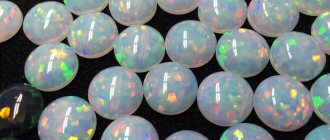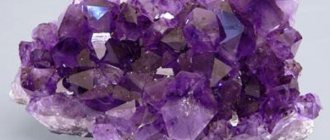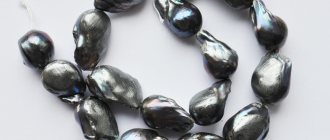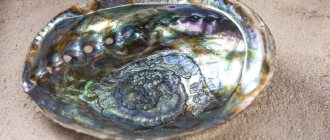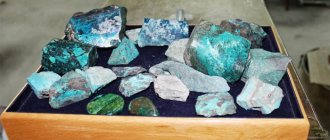How the stone was discovered
Zeolite is one of the few minerals whose “godparent” is known for sure. This is Swedish chemist Axel Kronstedt.
While conducting another experiment in the laboratory, he heated stilbite. Pieces of the mineral began to swell and bubbles appeared. They were born from water released during boiling.
The scientist identified other samples with similar characteristics. So in the middle of the 18th century, science was replenished with a new family of minerals, called the “parent” zeolites (from the ancient Greek zeo - boil and lithos - stone).
Natural zeolite
They didn’t know where to use the “boiling stones” then. For two hundred years, the results of the work were of purely theoretical value.
In the 1950s, the topic of water purification became topical. The stones interested scientists who were solving this problem. It was found that the mineral zeolite is a powerful sorbent. Without compromising the taste of water, it reduces the presence of calcium salts several times. Other chemical compounds could do this, but the advantage of zeolites was their prevalence and low price.
How zeolite was used for water in history
Having analyzed the information already available, we will highlight the main milestones:
Main table dispenser AquaPro 919H/RO (hot and cold water)
Main table dispenser AquaPro 929CH/RO (cooling/heating)
Floor dispenser AquaPro 311 (empty, without cooling)
- After the Chernobyl accident, it was bred and drunk to reduce damage from radiation sickness.
- In the 90s of the twentieth century, wastewater began to flow through its two-meter embankment for disinfection.
- In the 2000s, having already assessed its effect, it was used as a filter media that eliminates compounds of hydrogen sulfide, methane, and ammonia, but retains proteins, vitamins, amino acids, and harmless and useful organic matter with a complex structure.
Well, since the 18th century it has been a real find for traditional medicine. “Boiling stones” were immersed in the liquid, they settled it, believing that it became healing, and in some ways they were right, because drinking it strengthened the body.
Description and types of zeolite
Zeolites are a group of minerals, hydrous aluminosilicates:
- Mineral of sedimentary-volcanic origin. Once in salt water (ocean, sea), the mineral-lava mixture crystallizes.
- Chemical composition. Three quarters are silicon, 11–15% are aluminum, 9–10% are water. The remaining fractions of a percent are shared by two dozen elements. The formula of a particular type of mineral depends on the predominant component.
- According to the description, the agglomerates resemble dense clay. The usual color of crystals is white, sometimes they are colorless. There are brownish specimens, with reddish, greenish-gray tones.
- The hardness of the mineral on the Mohs scale is 3–5.
- Gloss: glassy, pearlescent.
Fifty types of zeolites have been identified, the most common being heulandite, lomonite, erionite, ferrierite, phillipsite, clinoptilolite, and mordenite. The last two are the most significant.
Special properties of the mineral
The loose but strong frame structure determined the properties of the minerals:
- Adsorption. The crystalline lattice binds heavy and radioactive metals, nitrates, and other toxins.
- Catalysis. The ability to accelerate chemical reactions is in demand in oil refining.
- Ion exchange. Due to their porosity, zeolites absorb molecules (water or others), releasing minerals.
- Molecular sieves. The uniqueness of zeolites is the strictly defined dimensions of pores and internal cavities. Each type of stone has individual characteristics. Crystals are able to calibrate molecules by absorbing or screening out different substances. For example, radioactive cesium or strontium is removed from water, “passing” other components.
Zeolite agglomerates are able to absorb water or toxins up to half their volume.
Areas of application
Thanks to their unique properties, stones are in great demand. The processing of natural zeolite and the synthesis of the mineral are on stream.
Scope of application of zeolites (click on photo to enlarge)
Industry
The mineral is in demand in several industries:
- Construction. With this additive, concrete becomes stronger and hardens faster.
- Chemical. They are used as mineral fertilizers or their components: they prevent caking of bulk fertilizers, make granular varieties stronger; raw materials are stored longer. Instead of environmentally hazardous phosphates, they are added to washing powders and other detergents, improving consumer properties.
- Oil production and refining. Minerals are added to raw materials to remove sulfur components, desalting, and dehydration. Catalyst for oil distillation.
- Housing and communal services. For purification of drinking and waste water. Tap water becomes softer.
Zeolites are used where it is necessary to quickly destroy moisture in large spaces or production areas.
The technical mineral is used as a filler in the production of plastics, rubber, oilcloth, and leather. Vegetables and fruits are stored longer in containers made of zeolite cardboard than in regular containers.
Agriculture
The benefits of zeolites are recognized by major areas of the industry.
Crop production
Fertilizers and mineral-based additives in demand:
- zeolite prevents bulk fertilizers from caking, making granular ones stronger;
- traditional mineral fertilizers are enriched with magnesium, manganese, iron, cobalt, and other microelements contained in zeolite;
- agricultural crops and other plants almost do not absorb harmful substances from the soil, suffer less illness, and produce increased yields;
- soils, saturated with nutrients, restore fertility and other conditions.
Zeolite for plants
Due to their ability to retain soil moisture, long-acting zeolite preparations are indispensable for arid regions.
Livestock
Natural zeolite is beneficial as a component of animal feed and is used for other purposes:
- feed is enriched with minerals, is stored longer, and does not grow moldy;
- animals absorb nutritional components better, gain weight faster, get sick less, reproduce better;
- Zeolite contains veterinary drugs for detoxification of the animal body.
The mineral is added to bedding for livestock and poultry: it effectively absorbs moisture and odors.
Fish farming
In man-made reservoirs, zeolite preparations destroy bacteria, viruses, and ammonium compounds.
Environmental protection
Natural zeolite is the main rescuer in situations dangerous to nature:
- spill of chemical substances (especially fuel oil, oil);
- contamination of water and soil with heavy metals and radionuclides;
- emissions of methane, carbon monoxide, ammonia, and other gaseous compounds;
- contamination of reservoirs, well or pool water with toxins.
The true significance of the mineral emerged after the Chernobyl disaster. Rescuers and residents of contaminated areas who took powdered zeolite suffered less from radiation.
Solving home or household problems
The stone is a lifesaver when solving everyday problems, including delicate situations:
- a water purification filter is a mandatory attribute of homes or offices; At the same time, zeolites soften water and make it more pleasant;
- UK residents love to use crushed zeolites as an absorber for the smell and smoke of tobacco; mineral crumbs effectively neutralize kitchen fumes or stagnant air in the refrigerator;
- as a fertilizer for plants and flowers: minerals make the soil fluffy, saturating it with oxygen;
- cat litter mixtures quickly absorb moisture, preventing odors from spreading;
- for cleaning aquariums - pebbles inhibit water blooms and absorb waste products of the inhabitants;
- a container with zeolite crumbs in the place where vegetables are stored, in the refrigerator, or a beautiful fabric bag in the bathroom will prevent waterlogging and mold;
- To dry and refresh shoes, place a bag (or an old sock) with loose zeolite in it overnight.
Using stone for an aquarium
By fertilizing your garden plot with such preparations, you get an environmentally friendly harvest - without heavy metals and pesticides.
Advice from experienced flower growers
Zeolite can be purchased as a ready-made substrate and cat litter component. The latter are cheaper and can also be used for plants. But before use, toilet filler must be rinsed.
Zeolite of small and medium fractions is very convenient in hydroponics - a method of growing plants in artificial media. It is often used in indoor floriculture for succulents.
- unlike gravel, it is porous and retains moisture;
- unlike pumice, brick chips and lechuza, it does not crumble over time and does not dust (or silt) the bottom of the pot;
- unlike vermiculite and perlite, it is not very light, so it does not spread from wind and draft and does not float when watering.
Leaf succulents and cacti feel great in zeolite and, under all other identical conditions, develop better than in organic matter.
Zeolite is an ideal substrate for orchids and violets. Moreover, it can be used in various ways:
- as a mulching and decorative material;
- as an additive to the base soil in volumes from 20 to 90%;
- as the main substrate.
Reviews for orchids are only positive: the roots grow 2-3 times more intensely than on ordinary soil or bark, the frequency of watering is reduced, the plants almost do not get sick, since their resistance to stress increases due to the silicon present in the substrate. Opinions differ about growing violets on zeolite, but mainly due to the fact that some gardeners have a fundamentally negative attitude towards growing flowers on any gravel.
Watercress or bedbug can be grown on a windowsill without any hassle, using zeolite as a substrate. This healthy, micronutrient-rich, unpretentious green vegetable crop does not require feeding. To get a rich harvest of watercress, you only need to water it occasionally, and everything else will come from the substrate.
Ocean zeolite is not suitable for plants - it dissolves. Therefore, if the packaging says volcanic mineral rock zeolite, as well as the word “oceanic” or “zeolite-containing clay, large granules,” do not buy it for plants.
Artificial zeolite
Artificial mineral is an achievement of the second half of the twentieth century.
Artificial zeolite
One and a half hundred types of zeolites are synthesized:
- They differ in the sizes of the pore windows and have two-digit designations: NaA, CaA, KA; NaX, CaX. The first indicator is the main metal, the second is the type of grating (A or X).
- The most popular synthetic types are A and X.
- Unique adsorption and catalytic capabilities are inherent in high-silica zeolites (especially the ZSM type). Therefore, their synthesis is of special importance.
The production technology of synthetic zeolites is as follows. Organic substances, water, alkalis, aluminum, silicon are loaded into the container. The mixture is crystallized by heating to 170–185 °C.
Drinking water purification
Human health directly depends on the quality and quantity of fluid consumed. You shouldn't rely on city cleaning systems, so it's better to do it yourself. The most common cleaning method at home is carbon filters. This is a good adsorbent, but over time it develops pathogenic bacteria, which will have an even worse effect on health.
Zeolite filters not only chemical contaminants, but also biological ones - the water will be absolutely safe and at the same time tasty.
Here is just a minimal list of substances retained by zeolite:
- metal impurities;
- nitrates;
- nitrites;
- iron;
- chlorides;
- bacteria;
- decomposition products of organic substances.
In addition to purification, zeolite also saturates the water with calcium, potassium and magnesium ions. They will strengthen the walls of blood vessels.
To further enhance the beneficial effects of zeolite water, it must be structured - frozen and then defrosted.
It will slow down aging and generate human energy. Water acts as a lubricant for joints and strengthens the immune system. You should drink 2-3 liters a day, depending on your weight.
The healing effects of the mineral
The abilities of zeolite are known even to the indigenous inhabitants of Oceania and Africa. They offer an edible variety of the mineral to guests after a heavy feast with alcohol. This eases hangovers or overeating.
The capabilities of the mineral are used in medicine:
- medications effective for food poisoning and flatulence (for example, the widely advertised Smecta);
- the mineral accelerates the healing of wounds in diabetes;
- in cosmetics these are therapeutic muds, masks that rejuvenate the skin; scrubs that remove cellulite.
For healthy people, the use of zeolite is indicated as a prophylactic agent for the following purposes:
- strengthening the immune system and nervous system;
- normalization of stomach acidity;
- removing toxins from the body that enter through food, water or air;
- everything related to microelements in the body: maintaining balance; prevention of diseases associated with their deficiency or excess.
A person who uses preparations with zeolite feels a surge of strength, is energetic, and works more productively.
However, in Russia only clinoptilolite, which serves as the raw material for the Litovit product, is certified as medical.
Mining locations
Zeolite deposits are scattered throughout the planet. Today, more than one thousand deposits are known in which “boiling stone” is mined. The most significant of them are located in the countries of East Africa, the USA, Russia, Japan, New Zealand, and Iceland.
In Russia, the Khabarovsk and Krasnoyarsk territories, the Kemerovo region, and the territories of the Urals, Chukotka and Sakhalin are famous for zeolite mining.
Zeolite has metamorphic and hydrothermal origin. Its deposits are formed at shallow depths in sand, shale and volcanic rocks.
How to use the stone
The rules for using the mineral are simple:
- Beads, bracelets or pebbles neutralize headaches, muscle spasms, and normalize blood pressure. They treat the spine, gynecology, urology, angina, liver, sinusitis.
- For treatment, a warm pebble (dipped in hot water) is applied to the problem area of the body.
- Zeolite baths (100 g of powder per two liters of water) help with varicose veins, fungal skin lesions, and swelling.
Beautiful zeolite stone
As healing stones, the stones are “reusable”, but after each healing session they are washed and dried in the sun.
How long will clinoptilolite last?
Buying zeolite is quite profitable, not only because it is a useful thing, but also because it can be refreshed and used again and again indefinitely.
For refreshment, the stones are left outside on a bright sunny day to allow sunlight and fresh air to carry away the odors and pollutants absorbed by the minerals. To ensure that clinoptilolite is completely cleaned, it is left outdoors for two or three days in direct sunlight.
If you place the zeolite on a table or some kind of box, then you need to turn it a couple of times a day so that sunlight and fresh air touch it from all sides. An even better idea is to hang it in a breathable bag.
If you are using small stones, granules or powder, place them on a tray or bowl and leave them outside.
Regarding the aquarium product, these pebbles are washed under hot water and left to dry in the sun for several days, and then they are placed in the filtration system in the aquarium.
On dark, gloomy days, clinoptilolite can be refreshed in the oven. If the granules are pre-packaged in a plastic bag, simply place it in the oven for one hour to allow the heat to circulate through it. Be careful not to exceed the temperature of 200 degrees F (93º C) or the plastic bag will melt.
Clinoptilolite powder can be scattered on a baking sheet and dried for an hour or two. Natural zeolite can withstand very high temperatures (over 1000 degrees Fahrenheit), but keep your oven at an adequate temperature for your safety!
How often should I refresh zeolite?
The refresh rate depends on how often you use it and how bad the odor or dirt problem is. For musty closets, basements and attics it will probably last two or three months.
In a very musty smoking room, it can be refreshed once every week or two. In an aquarium, it is replaced every time the filter is changed.
It's better to rely on your own feelings. If you start to smell it, refresh your clinoptilolite. It's good when you have several of them, when one is refreshed on the street, you use the other, and vice versa.
This crystallized mineral is completely safe to use in the home, even if you have children and pets.

